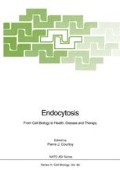Abstract
The degradative action of lysosomes depends primarily on the hydrolytic enzymes present within their lumen. However, the number of lysosomes per cell and their level of activity is regulated by events controlled by constituents of their limiting membrane. Therefore, study of formation of new lysosomes, the composition of lysosomal membranes and their maintenance is the basis for understanding the biology of lysosomes. Much is known about the biosynthesis, sorting and turnover of soluble lysosomal enzymes (Von Figura and Hasilik, 1986; Kornfeld and Mellman, 1989). They are targeted through endosomes to lysosomes via the mannose phosphate receptor (MPR). In the endosomes MPR separates from the ligand (the soluble lysosomal enzyme) and returns to the Golgi complex or the cell surface, while the enzyme is transported to the lysosomes. Other mechanisms to direct proteins to the lysosomes must exist (Neufeld and McKusik, 1983). The glycoproteins of the limiting lysosomal membrane have no mannose 6-phosphate and yet are very efficiently transported to the lysosomes. In addition, some enzymes such as glucocerebrosidase (deficient in Gaucher disease) and acid phosphatase have their own unique pathways to reach the lysosomes (Erickson, et al., 1985; Braun et al., 1989). We We have studied the intracellular transport between the Golgi complex and the lysosomes of two lysosomal glycoproteins cathepsin D, a MPR-dependent soluble enzyme and glucocerebrosidase, a MPR-independent enzyme after their synthesis in the rough endoplasmic reticulum (RER).
Access this chapter
Tax calculation will be finalised at checkout
Purchases are for personal use only
Preview
Unable to display preview. Download preview PDF.
References
Bangham, A.D., and Home, R.W. (1962) Action of saponin on biological membranes. Nature 196, 952–953.
Braun, M., Waheed, A., and Von Figura, K. (1989) Lysosomal acid phosphatase is transported to lysosomes via the cell surface. EMBO J. 8, 3633–3640.
Diment, S., Leech, M.S., and Stahl, P.D. (1988) Cathepsin D is membrane-associated in macrophage endosomes. J. Biol. Chem. 263, 6901–6907.
Kornfeld, S., and Mellman, I. (1989) The biogenesis of lysosomes. Annu. Rev. Cell Biol. 5, 483–525.
Neufeld, E.F., and McKusik, V A. (1983) Disorders of lysosomal enzyme synthesis and localization: I-cell disease and pseudo-Hurler polydistrophy. eds. JB Stanburry, JB Wyngaarden, DS Frederickson, JL Goldstein, MS Brown) In: The Metabolic Basis in inherited disease, pp. 778–787.
Prieels, J.-P., Pizzo, S.V., Glasgow, L.R., Paulson, J.C., and Hill, R.L. (1978) Hepatic receptor that specifically binds oligosaccharides containing fucosyl α1–3 N-acetylglucosamine linkages. Proc. Natl. Acad. Sci. USA 75, 2215–2219.
Rijnboutt, S., Aerts, H.M.F.G., Geuze, H.J., Tager, J.M., and Strous, G J. (1990) Mannose 6-phosphate-independent membrane association of cathepsin D, glucocerebrosidase and sphingolipid-activating protein in HepG2 cells. J. Biol. Chem. in press.
Strous, GJ., and Van Kerkhof, P. (1989) Release of soluble resident as well as secretory proteins from HepG2 cells by partial permeabilization of rough endoplasmic reticulum membranes. Biochem. J. 257, 159–163.
Von Figura, K., and Hasilik, A. (1986) Lysosomal enzymes and their receptors. Annu. Rev. Biochem. 55,167–193.
Wassler, M., Jonasson, I., Persson, R., and Fries, E. (1987) Differential permeabilization of membranes by saponin treatment of isolated rat hepatocytes. Release of secretory proteins. Biochem J. 247, 407–415.
Author information
Authors and Affiliations
Editor information
Editors and Affiliations
Rights and permissions
Copyright information
© 1992 Springer-Verlag Berlin Heidelberg
About this paper
Cite this paper
Strous, G.J., Geuze, H.J., Aerts, H.M.F.G., Tager, J.M., Rijnboutt, S. (1992). Mannose Phosphate-Independent Membrane Association of Lysosomal Enzymes Occurs After Passage of the Golgi Complex. In: Courtoy, P.J. (eds) Endocytosis. NATO ASI Series, vol 62. Springer, Berlin, Heidelberg. https://doi.org/10.1007/978-3-642-84295-5_28
Download citation
DOI: https://doi.org/10.1007/978-3-642-84295-5_28
Publisher Name: Springer, Berlin, Heidelberg
Print ISBN: 978-3-642-84297-9
Online ISBN: 978-3-642-84295-5
eBook Packages: Springer Book Archive

